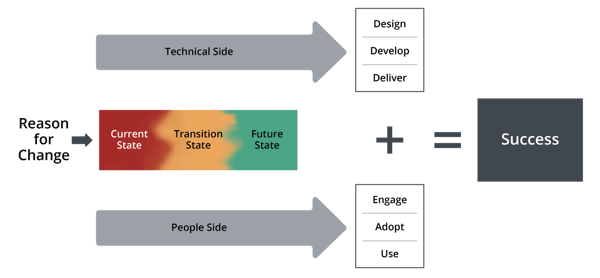Why Defining the Scope of Change Management is Critical

3 Mins
Updated: March 2, 2024
Published: December 6, 2022

How do you establish the scope of change management, and why does it matter? By creating and sharing a working definition and scope for change management, you will be able to work more effectively with others in your organization to successfully implement changes.
Change Management Scope
As with any discipline or methodology, it is important to distinguish between the activities that fall within the scope of change management and the project management activities that occur in parallel or in collaboration with change management. The benefits of establishing a clear scope include:
- Dividing work and avoiding overlap between the two disciplines
- Ensuring that all key activities are completed
- Showing the relationship between existing techniques and approaches
- Defining the skills and competencies required to perform the work effectively
Successful change requires integrating the technical side and people side of change.
Use the ADKAR Model to integrate your approach and achieve more successful outcomes.
Risks and Change Management Scope
There is an inherent risk of not clearly establishing scope. It becomes very easy for one group to believe that they are responsible for work that falls under the work responsibilities of another group, resulting in confusion and ineffective workstreams.
For example, imagine the confusion that would result in developing a new product if there wasn't a clear distinction between software development, hardware development, physical design and system test. The specific skills and competencies needed to develop software differ from the skills needed to design circuit boards or the physical housing for a product. In the same way, the skills and competencies for project management are specific and very different from change management.
Understanding the respective scope and boundaries enables both disciplines to work effectively together while avoiding any overlap of activities that may create conflicts for the project. The boundaries also enable the separation of solution design, development and implementation from the actions required to manage the technical side and people side of that solution's deployment.
Scope and the Unified Value Proposition
Prosci's Unified Value Proposition model provides a framework that identifies the key elements of implementing a change within an organization. The Unified Value Proposition shows how the technical side of change (project management) and people side of change (change management) must come together to ultimately deliver success for a change initiative. Success is defined as meeting or exceeding project objectives and realizing organizational benefits.

Objectives that impact scope
| Reason for the Change | |
| Objective: Identify the internal or external stimulus resulting in the need for change | |
| Examples: | |
|
|
| Technical Side – Project Management | |
| Objective: Manage the overall effort to design, develop and deliver a solution that solves a problem or addresses an opportunity (not necessarily a technology-driven solution) | |
| Examples: | |
|
|
| Technical Side – Project Management/Solutions Development (design and develop solution) | |
| Objective: Design and develop a solution to improve the performance of the organization based on the recognition that a change is needed | |
| Examples: | |
|
|
| Technical Side – Project Implementation (deliver solution) | |
| Objective: Install a solution that meets technical requirements and is adopted and utilized by members of the impacted groups | |
| Examples: | |
|
|
| People Side – Change Management Strategy and Planning | |
| Objective: Develop a strategy and plans to support impacted people to engage, adopt and use the solution effectively in their day-to-day work | |
| Examples: | |
|
|
| People Side – Change Management Implementation | |
| Objective: Implement the strategy and plans to enable impacted people to engage, adopt and use the solution effectively in their day-to-day work | |
| Examples: | |
|
|
Scoping Change Management
While some overlap between the change management and project management disciplines is normal and to be expected, the Unified Value Proposition can assist in answering the question, “Who should do what?” The Unified Value Proposition can also help you make sense out of the many elements of successful change—from recognizing the need to develop the solution to managing the technical and people sides of solution deployment.



